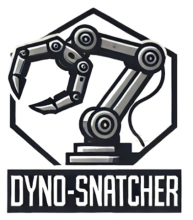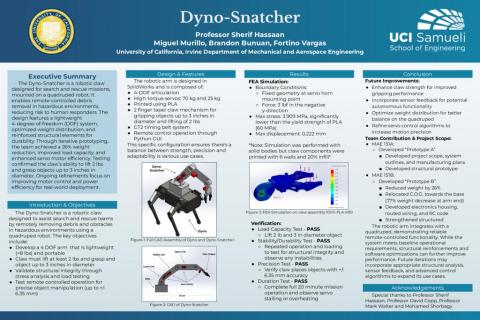Dyno Snatcher
Background
Search and rescue operations often take place in hazardous environments where debris, tangled wires, and other obstacles block access to critical areas. These challenges require tools that can safely and efficiently clear paths without risking human lives. While quadruped robots like Dyno offer mobility and adaptability, they often lack the ability to manipulate their surroundings effectively.
Our project aims to address this limitation by developing an RC claw specifically designed for Dyno. This claw will enhance the robot’s functionality, enabling it to remove obstacles and navigate complex terrains autonomously or via remote control. By combining portability, flexibility, and precision, this solution bridges the gap between mobility and environmental interaction, making robotic assistance in disaster scenarios safer and more effective.
Meet Dyno: The Robot Behind the Claw
Dyno is a versatile quadruped robot designed for mobility and adaptability in challenging environments. Equipped with advanced sensors and precise movement capabilities, Dyno navigates rough terrains and hazardous areas. By integrating the RC claw, Dyno’s functionality expands to include obstacle manipulation, enabling it to clear debris, tangled wires, and other obstructions during search and rescue missions.
Goal and Objectives
Quarter 1: Research, Design, and Prototyping
- Week 2: Conduct research and develop preliminary concepts.
- Weeks 3-4: Define requirements and create early sketches.
- Weeks 4-5: Select components and refine design.
- Week 5: Validate design through reviews and prepare for CAD modeling.
- Week 6: Create and finalize a detailed CAD model.
- Week 7: Finalize BOM, order parts, and begin assembly.
- Week 8: Complete mechanical assembly and integrate motors.
Quarter 2: Integration, Testing, and Optimization
- Weeks 1-2: Develop software and test basic functions.
- Weeks 3-4: Calibrate and test grip performance.
- Weeks 5-6: Integrate claw with Dyno and test functionality.
- Weeks 7-8: Implement advanced controls and test in dynamic environments.
- Weeks 9-10: Final optimization, testing, and documentation.
Preliminary Design Review
https://docs.google.com/presentation/d/12_QdPjAX0VHAGC7Pe0SNBseW0Cke5Wnq...
Below is attached our team photo and our respective roles.
Team Contact
Miguel Murillo | murillm4@uci.edu
Bradon Bunuan | bbunuan@uci.edu
Fortino Vargas | fortinov@uci.edu
Sponsor
Shorbagy Mohamed | mohamem2@uci.edu


